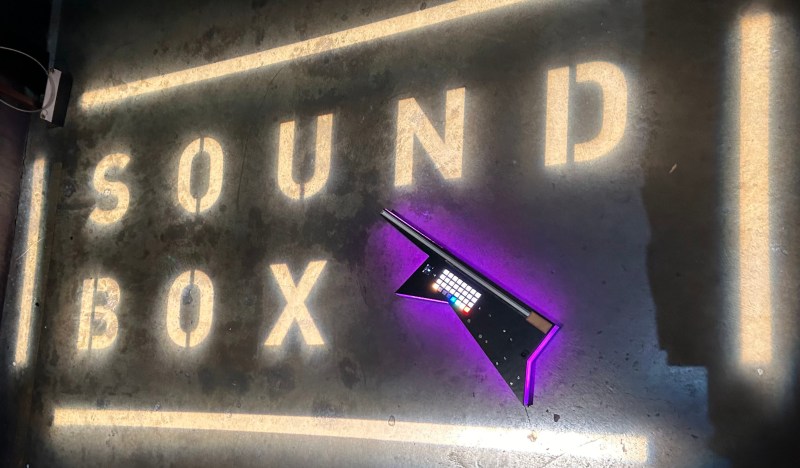Violins, “Megamind” memes and electrical engineering.
These seemingly disparate ideas were brought together by a student-designed instrument featured at an exhibit in the SoundBox rehearsal space with the San Francisco (SF) Symphony on April 5.
From YouTube inspiration to stage

The instrument, known as the Modulin, was the brainchild of Caleb Matthews ’25 M.S. ’26, who was inspired by YouTuber Wintergatan’s instrument of the same name. Matthews described the Modulin as a “single-string, digital violin that has a drummer and back-up pianist stuffed somewhere inside of it.” The player slides their finger along a ribbon sensor, a shared feature with Wintergatan’s Modulin, and presses buttons to play accompanying piano chords or drum beats.
Matthews chose to implement the ribbon sensor based on his experience with the ukulele, guitar and banjo while growing up.
“I picked up all those kinds of strumming instruments, but I’ve always loved violins. They sound really cool but they don’t have frets and that scares the daylights out of me,” Matthews said. “You have to put your finger exactly where you want to be. If you’re slightly too far or slightly too shallow, it’s sharp or flat and I’m a perfectionist, and that’s terrifying.”
With the Modulin, Matthews said, he aimed to create an approachable form of music-making.
This aspiration was put to the test when SF Symphony Collaborative Partner and concert curator Carol Reiley invited Matthews to display the instrument during interactive intermissions at an April 5 concert. The concert, titled “Press Play: Carol Reiley & The Robots,” and the accompanying exhibit celebrated the cross-over of AI, robotics and the arts.
The immersive elements of the Modulin aligned with the experiential goals of Reiley’s curation process.
“I really wanted to touch on playfulness and human connection,” Reiley said. “[The Modulin] is a good example of a hands-on showcase where you get to see a disruptive technology and be able to play with it.”
A handful of audience members experimented with features beyond the violin-mimicking ribbon sensor. They tested out the button grid, producing drum beats and piano chords when hooked up to the MainStage application. Sound production was also coordinated to different hues of LED lights displayed on the side of the instrument.
“Those who would set up a little drum loop in a way that they liked and then go from there seemed to have the most success, but there were people just trying different things, like ‘What if I tried to hold it like a guitar?’” Matthews said. “It was almost like a group experiment that was really satisfying to be a part of.”
Making the Modulin with Moonshot
Creating the Modulin also involved group experimentation among Matthews and other members of the Moonshot Club, a student organization aimed at making any student project come to fruition.
The instrument’s unorthodox shape was rooted in the idea of incorporating a modern feel into the music production process. This called for a modern shape, said James Clark ’25, who spearheaded instrument design. Clark said he drew inspiration from online media, including a particular “Megamind” meme.
“As I was sketching more, all I could see was that ‘Megamind’ meme in the shape, where he was grinning with an eyebrow raised,” Clark said. “So I sketched out something that gave [the Modulin] a throwback feel, a fun punk, futuristic quality which we all really liked.”
Gabriel Tsai ’27 debugged the code that ran the “cyberpunk-y” instrument, working with the programming language Arduino for the first time.
In order to finish the instrument before the show, the team had to prioritize the development of some features over others, Tsai said.
“You start out really ambitious, but then as time goes on, you realize, ‘Maybe we’re getting in over our heads,’ so you have to unfortunately whittle down a lot of functionality,” Tsai said.
Backstage lab work
Making the Modulin come to fruition didn’t just call for collaboration. It also required timing and resources that weren’t available to Matthews when he was initially inspired by Wintergatan’s Modulin as a middle schooler. The key component of Wintergatan’s Modulin was a ribbon controller that transferred information about finger position to the modular synthesizer, which is “fancy, expansive audio hardware,” according to Matthews.
“I thought it was really neat and I looked up what modular synthesizer components cost and I was like, ‘I don’t have $10,000, so I’m going to not do that.’ But I’ve always thought it was kind of interesting,” Matthews said.
After arriving at Stanford, Matthews found his chance to create the instrument with peers in Moonshot Cub in the Electrical Engineering-run makerspace Lab64. A handful of music-adjacent projects have passed through the lab, which prioritizes supporting students no matter their endeavor, according to lab manager Jeff Stribling M.S. ’94 Ph.D. ’98.
“I have seen a couple of music based projects ranging in things like amplifiers and guitar effect pedals. It’s just everyone has their own thing they’re doing,” Stribling said. “The key is making sure that we can provide the tools that they need or the education to help them see this thing through.”
Beyond the musical aspects of the Modulin, the project’s emphasis on building community rather than replacing century-old instruments stood out to Moonshot Club member Rohan Tan Bhowmick ’27.
“I kind of oscillate between creative optimism and pessimism. On one hand, I think it’s really cool. On the other hand, I think, ‘We already have so many instruments, why bother making another one?’” Bhowmick said. “But I do think really, in the end, it’s about learning through making and being able to share something cool you’ve made with hundreds of people.”
